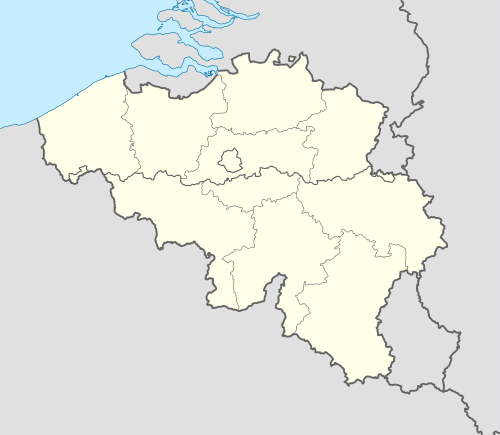Forest, Belgium
Forest (French name, pronounced [fɔʁɛː]; Dutch: Vorst [vɔrst] (![]()
Forest | |
|---|---|
 Flag  Coat of arms | |
 Forest Location in Belgium
Forest municipality in the Brussels-Capital Region  | |
| Coordinates: 50°49′N 04°19′E | |
| Country | Belgium |
| Community | Flemish Community French Community |
| Region | Brussels |
| Arrondissement | Brussels |
| Government | |
| • Mayor | Stéphane Roberti (Ecolo) |
| Area | |
| • Total | 6.25 km2 (2.41 sq mi) |
| Population (2018-01-01)[1] | |
| • Total | 56,008 |
| • Density | 9,000/km2 (23,000/sq mi) |
| Postal codes | 1190 |
| Area codes | 02 |
| Website | www.forest.irisnet.be |
The municipality is commonly known for its concert hall: Forest National/Vorst Nationaal. It also houses an important jail, an Audi factory and a railway depot that is home to the Belgian fleet of Eurostar train sets.
History
Frankish origins and medieval period
The first houses built in this forested area along the Geleysbeek, a tributary of the Senne, date from the 7th century. The village's first church was dedicated to Saint Dionysius the Areopagite. The legend of Saint Alena, a young convert to Chalcedonian Christianity murdered by her father's troops for hearing mass at the church of Dionysius, also takes place in the 7th century. The chapel and cult of Saint Alena, however, date only from the 12th century. The saint's cenotaph, one of the rare examples of 12th-century sculpture in Belgium, can still be admired in the chapel today. The contiguous church of Saint Denis (Dionysius) was rebuilt in the Romanesque style at around the same time.
The abbots of Affligem, which had been the ecclesiastical owners of the parish since the bishop of Cambrai ceded it to them in 1105, decided to build a priory for women in Forest; Forest Abbey. The first abbess of the Forest priory was appointed in 1239. Also in the 13th century, the Romanesque church of Saint Denis was rebuilt in the newer Gothic style. The neighbouring abbatial church was rebuilt in the 15th century.
17th century until today
During the period of the Austrian Netherlands, especially during the reigns of Archdukes Albert and Isabella, Forest prospered, thanks to its abbey. On 26 March 1764, however, a devastating fire ruined some of the buildings and destroyed many of its artworks. Three decades later, in the years following the French Revolution, the religious community was disbanded, the nuns forced to flee, and the buildings sold. The Forest municipality bought the abbey in 1964 and proceeded to restore it to its previous glory.
Sights
- The Church of Saint Denis and the adjoining chapel of Saint Alena house unique specimens of Romanesque sculpture. The nearby Benedictine abbey is now home to a cultural centre.
- The Art Deco town hall, built in 1925 and inaugurated in 1938, is located near the old historic centre.
- The Church of St. Augustine on the Place de l'Altitude Cent/Hoogte Honderdplein (a square named due to its altitude one hundred meters above sea level), also in an Art Deco style.
- The Wiels Contemporary Art Centre, housed in the old Wielemans-Ceuppens brewery.
- Finally, the municipality maintains several green areas, including the Duden Park and the aptly named Forest park.
Art Deco town hall Church of Saint Augustine 
BRASS, the machine room of the former Wielemans-Ceuppens brewery 
BRASS, public library BLI:B
Events and folklore
- The Forest National (Dutch: Vorst Nationaal) concert hall is well known in the world of show business, arts and culture, as one of the prime venues for international star performances.
- On the grounds of Forest Abbey, a three-day-long “Medieval Celebration” is organised in September, where hosts and visitors alike are dressed as knights, burghers, soldiers, and a variety of other medieval attire. Typical activities include watching assorted magicians, jugglers and fire-eaters, listening to musicians perform on period instruments, appreciating old-time crafts, and tasting forgotten drinks and dishes.
- Since 1987, Forest has giant puppets of its own: Nele and Pauline, both baptised at the abbey, and their children, Alida and Paville.
Famous inhabitants
- Stuart Merrill, American poet (1863–1915)
- Jean Delville, symbolist painter, writer, and occultist (1867–1953)
- Louise Ochsé, sculptor (1884-1944)
- Paul Vanden Boeynants, politician (1919–2001)
- Raymond Goethals, football coach (1921–2004)
Twin cities
References
- "Wettelijke Bevolking per gemeente op 1 januari 2018". Statbel. Retrieved 9 March 2019.
External links
| Wikimedia Commons has media related to Vorst-Forest. |
- Forest official web site, in Dutch and French
- Forest National website, in Dutch and French
